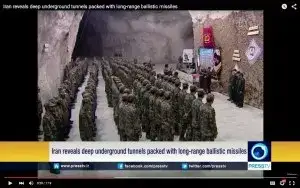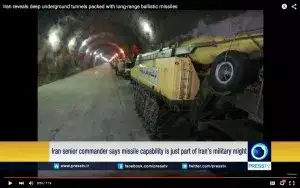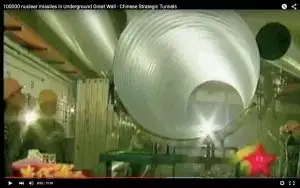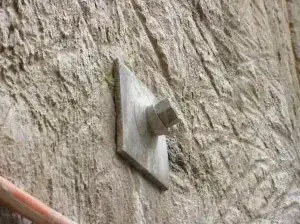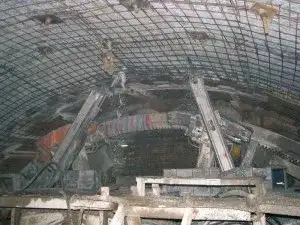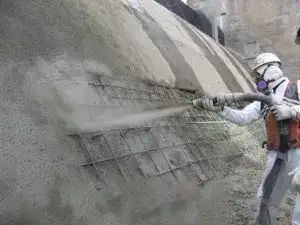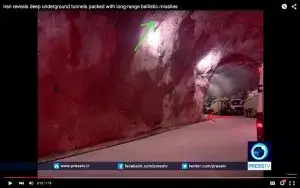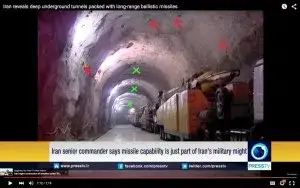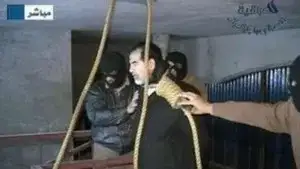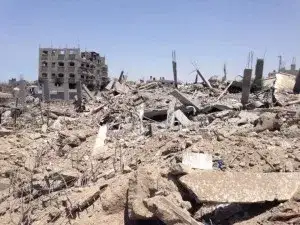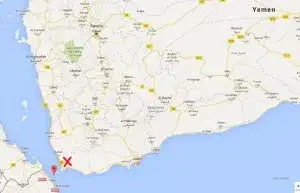Iran’s fake ballistic-missile tunnels
October 15, 2023 by Thomas Wictor
If the Iranian mullahs and their lackeys weren’t so evil, I’d feel sorry for them. However, they’ve made thirty-six years of choices that add to up a richly deserved demise. In a pathetic attempt to ward off this fate, Iran has released a fake video of what it says are tunnels used to store their giant collection of ballistic missiles.
Where to begin?
The report says that the tunnels are over 500 meters (1640 feet) underground. Each of the transport erector launcher (TEL) vehicles has a different number of Iranian Revolutionary Guard Corps (IRGC) missileers as its crew, depending on the type of weapon. These appear to be Shahab-3, Ghadr, and Sejil missiles; the vehicles therefore have five, six, or eight crewmen. A rough count of the missileers gives us twenty-three TEL vehicles.
So, we’re 500 meters underground, and the alarm is given. The twenty-three TEL vehicles start their engines, preparing to drive to the surface to defend the fatherland.
And then everybody dies of carbon-monoxide poisoning because there’s no ventilation system in these tunnels.
Chinese missile tunnels have massive air ducts.
Maybe IRGC missileers can hold their breath for a really long time. There is no evidence of a ventilation system in any of the video, including the longer versions. We see one power cord on each wall for the lights, and that’s it.
The Iranian video is a poor representation of a tunnel made by drilling and blasting (D&B). In order to keep the roof and walls from collapsing, you stabilize and reinforce the surface. There are several ways to do this, the most common being the New Austrian Tunneling Method (NATM), which utilizes rock bolts and shotcrete. This is a rock bolt and plate.
A long hole is drilled in the rock and filled with an adhesive such as epoxy. Then the bolt is screwed in and tightened. You can see the raw, unfinished rock behind the plate.
Depending on how unstable the rock is, sometimes a steel mesh is applied before the rock bolts are installed.
Then the mesh and bolts are sprayed with shotcrete—concrete projected through a hose at high velocity.
There’s no way that the rounded edges (red arrow) at the bottom of the tunnel could be achieved with a shotcrete sprayer.
The green arrow shows some steel mesh peeking out. In the screen grab below, the red arrows indicate rock bolts installed haphazardly and covered with such a thin layer of shotcrete that the steel mesh is visible in several places.
Each green X indicates a prefabricated arch. The finished product is a mishmash of several tunneling methods.
My guess is that this is a huge movie set. It isn’t a real underground missile depot. The shoddy workmanship would make it a deathtrap for all those IRGC missileers. If that were actual rock, the roof would be ready to collapse under its own weight. Shotcrete must be applied in a thick, even layer in order to function as a strengthener. Also, the cast arches are so far apart that even if they were concrete, they would add no structural integrity.
The mullahs create this garbage for domestic consumption. They know that Israeli and Arab League experts would laugh at such a video. The average Iranian, though, is fooled into thinking that the mullacracy is invincible, so why bother with another revolution?
Since the mullahs are putting all their energy into quelling domestic unrest, it means that they think that a war is not going to happen. Like Saddam Hussein. He was so sure that the US wouldn’t invade that he made no plans for his escape. Look where he ended up.
It was the same with Muammar Gaddafi.
He refused to flee when he had the chance, and he died horribly, a knife jammed up his rear end.
What the mullahs and their lackeys don’t understand is that they’re not going to be facing the US. Israel and the new assault units of the Arab League, Pakistan, Turkey, and Africa don’t fight the way Americans do. Even with the strictest rules of engagement on earth, the IDF utterly demolished the Hamas and Palestinian Islamic Jihad fortress of Shijaiya.
Thirteen Israelis were killed, along with about seventy Palestinians. I’ve said it before, but that’s science fiction made real. By all accounts the terrorists carried out the largest ambush in the history of urban warfare. Because the IDF wanted civilians to evacuate, the terrorists had four days to prepare. They set off massive improvised explosive devices (IEDs), which caused the overwhelming majority of the damage and civilian casualties.
Even so, less than 100 people died in this.
Studying the Yemen war has shown me that the Arab League can fight like the IDF. Read the words of Dr. Sultan Bin Ahmad Sultan Al Jaber, UAE Minister of State and Chairman of the Board of the National Media Council.
In only 6 hours, coalition forces secured territory overlooking the Bab Al Mandab Straits—a channel-barely sixteen miles wide at its narrowest point—that links the Indian Ocean to the Red Sea and the Suez Canal.
Thousands of Houthis and their allies had held the Yemeni side of the Straits since March of this year. In six hours, the Coalition used air strikes, naval fire, a ground attack, and an amphibious landing to regain control of this strategically vital area.
It was an AMAZING operation carried out effortlessly.
Last night I read an Iranian article that said that the Syrian Civil War is now being fought almost entirely by Iran. They’re losing badly. Most of their senior unconventional-warfare experts have been killed. And guess who’s had enough?
MOSCOW — With Russia’s air campaign in Syria now in its third week, Vladimir Putin has raised his nation’s global profile and proven its capability to project military power far from its borders. Now the Russian president could already be on the lookout for an exit strategy to prevent his gains from turning into a liability.
Putin certainly realizes that some 30 Russian combat jets won’t be able to change the course of the war, and allow Syrian President Bashar Assad’s forces to win…
Even though the air campaign in Syria, the first Russian military operation outside the former Soviet Union since the Cold War, hasn’t yet put any significant additional burden on Russia’s crisis-stricken economy, there are strong reasons for the Kremlin to avoid long-term involvement in the conflict.
Putin has said that Russia’s military action, which began on Sept. 30, will last as long as it’s necessary to support the Syrian army’s operations. While Assad’s troops have launched a new offensive in central and northwestern Syria under Russian air cover, their effort is unlikely to significantly change the situation on the ground.
Protracted Russian military action without any visible gains by the Syrian army would quickly erode the propaganda effect Putin has achieved with his bombing blitz. On the other hand, broader military involvement — let alone ground action — would strain Russia’s financial and logistical resources to the limit and could quickly sap domestic support for the Syrian campaign.
The Arab League retakes the Bab Al Mandab Straits in six hours, Iran publishes videos of fake missile tunnels, and Russia is ready to head home.
What do you suppose is going to happen to the mullahs?
This article viewed 1063 times.

